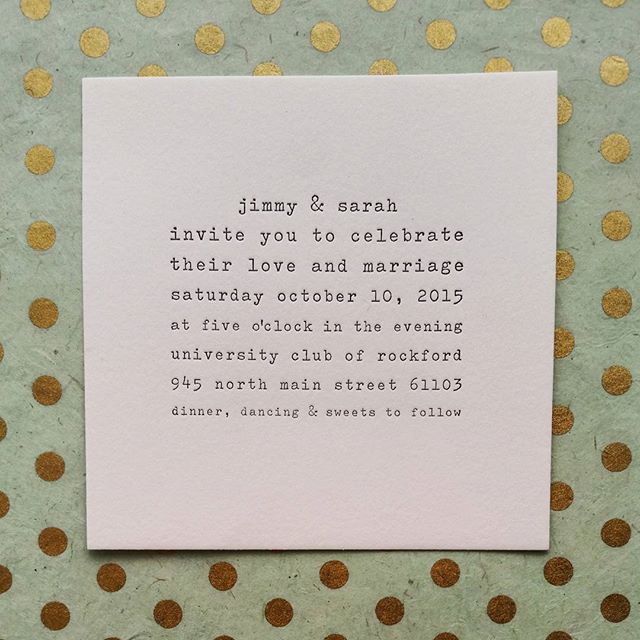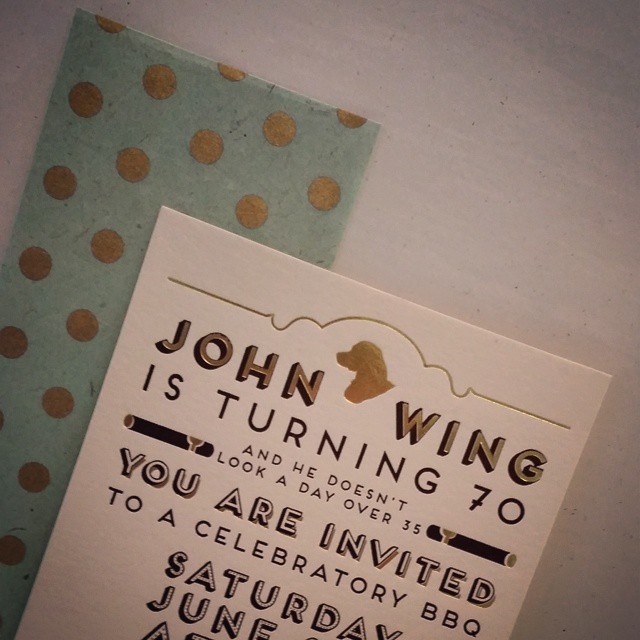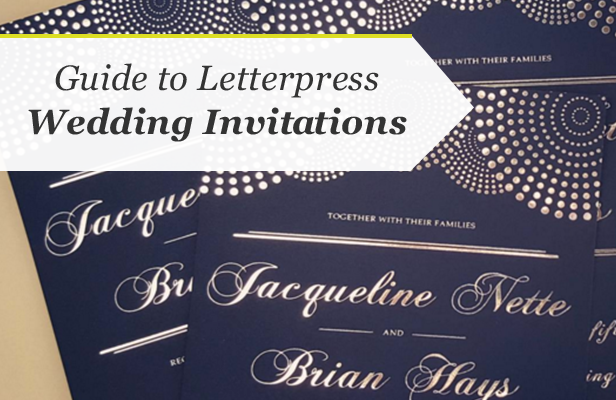
For a truly special occasion such as your wedding, you want everything to be perfect, from the luxurious dress and choice of flowers down to the table centerpieces and the save the dates or
invitations. There are many different types of wedding invitations, with styles as unique as the couples that design them. One of the most unique and customizable types is a letterpress invitation, made using a centuries-old technique.
We’ve seen every type of letterpress invitation come through our shop, and have compiled a list of our favorite tips and tricks, as well as an overview on the history and printing process of letterpress wedding invites, the pros and cons of ordering them for your own special day and the ways you can make them more cost-effective if you have your heart set on them.
Letterpress Printing Through the Ages
The first moveable type printing press originated in the 1440s, when Johannes Gutenberg wanted a way to mass produce the Bible. He started with wood block printing, and then he transitioned to metal type to achieve the print clarity he wanted. Through this true hand craftsmanship, his press printed 180 copies of the Bible over a span of three years.
As the centuries passed, many advances in printing and typefaces were made. Gutenberg’s printing press model stayed largely the same over the years, but his letterpress method was overtaken by offset printing in the 1950s and was mostly phased out in favor of this modern technique.
However, the oldest form of printing had a revival in the 1980s with innovations such as photopolymer plates and digital integration. In the beginning, letterpress printers were instructed not to make much of an impression in the paper, and the way the ink barely touched the surface was referred to as “kiss and print.” Nowadays, with the availability of thick, cushy paper, printers are able to produce deep impressions and tactile designs.
Flat Printing vs. Letterpress Printing
If you have a printer hooked up to your computer at home, it performs what is called flat printing. It is named as such because the paper comes out completely smooth. It is also referred to as digital printing, because whatever images you create on the computer can be instantly and exactly reproduced on the page.
The difference between flat printing and letterpress printing is that letterpress uses much thicker paper and leaves an impression you can feel. While this certainly has its own novelty, the benefit of flat wedding invitations is that they’re inexpensive and give you greater flexibility in design. To get the best of both worlds, digital printing can be combined with letterpress and foil printing to provide a unique touch while keeping overall costs in check.
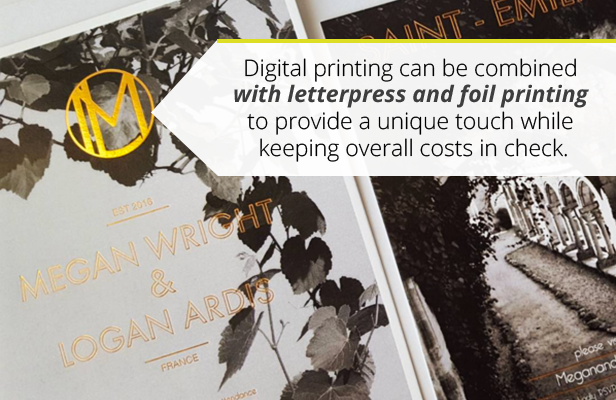
The Process of Letterpress Printing
Even with the modernization of letterpress printing, the process is still handled with antique machines. Most shops use letterpress machines that date back as far as the 1890s, with the most recent machines being from the 1960s. Though the equipment may be old, it produces prints of an amazing quality.
The three main components of letterpress wedding invites are deciding what paper to use, creating plates for the invitation design and determining the best schedule for the printing time.
There are many types of paper for wedding invitations, and virtually any kind can be used. If you want to get the best impression possible, you should go with some sort of textured paper, such as cotton paper. Cotton paper comes in different weights. The best paper for wedding invitations is slightly thicker, including weights of cotton paper that are 110lb, 130lb or even as high as 220lb. These are a bit more expensive but also a lot easier to work with during letterpress printing.
When it comes to multiple colors, the main thing you should realize is that each color you want requires a separate letterpress die. They are produced with the design and lettering of your wedding invites, then the dies are placed over the paper to make a print on the page. Not every letterpress studio has their own die maker on hand, so many times they need to source from other companies.
If you need fewer than 200 invitations printed, the smartest way to go is to have them done by hand. There are more automated machines out there, but their typical run is a minimum of 1,000 pages.
Letterpress printing is very much a manual process. The ink is mixed by hand, the press is set up one color at a time and then the paper is individually fed through. With these manual production machines, even the most skilled printers need a lot of time to complete the job. As an example, the average two-color, 100-invitation print run could take anywhere from six to eight hours.
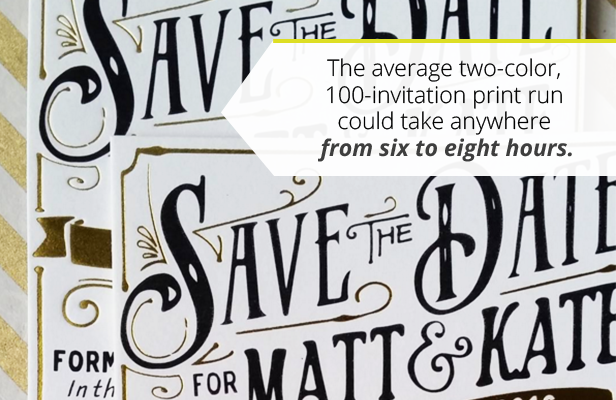
Advantages of Letterpress Invitations
So, why choose letterpress printing for your wedding invitations? If the process is so complex, why not keep things simple?
It’s important to note that this complexity lends itself to detailed, high-quality craftsmanship. Letterpress wedding invitations are in demand because of that incredible quality. As stated previously, letterpress printing is usually done with ink on cotton paper to create crisp, clean lines and bold patterns. The texture and thickness of the paper, along with the deep impression of the print, makes them unique and special – in a way that is hard to duplicate using digital printing only.
Letterpress invitations are gorgeous and luxurious, featuring stunning visual definition. Because they are handmade one at a time, each piece is original.
What to Consider when Choosing Letterpress Invitations
Letterpress wedding invitations cost more than the typical digital invitation. A single letterpress die can run in the $50-$100 range.
Another factor in the price you pay is the amount of time invested in the printing process. As mentioned earlier, it takes a while to get the printing job done just right. There’s manual pressing, cutting everything neatly and making any necessary touch-ups or revisions. If you are prone to making a lot of changes or need invitations quickly, then letterpress printing may not be the right choice for you.
Letterpress printing also comes with some style limitations. Fewer colors are ideal both from a process and price stand point, and there are also certain designs that cannot be translated properly through letterpress. Printing any sort of images, for instance, is difficult when using just letterpress printing. Gradients can be more challenging with letterpress but can be achieved with the right technique.
Ways to Be More Cost-Efficient
Interested in letterpress printing, but hesitant about the cost or want to include images or gradients? Thanks to the innovation of technology, there is a way to work around these issues by combining digital printing with letterpress or foil stamping. Locust Street Press is able to combine letterpress and digital printing, which can be especially tricky on the heavier paper required for letterpress.
Another way you can make wedding invitation letterpress printing less expensive is by keeping the amount of colors used for the letterpress to a minimum. As mentioned earlier, each color on your invitations requires its own die. Sticking with only one or two is best. You’d be surprised at how stunning these are even with less colors. Many brides also opt for printing on a variety of colors of paper, or colored envelopes to add to the drama of their invitation. Adding a fun, vibrant postage stamp is another way to easily add a pop of color to the overall look of these invitations.
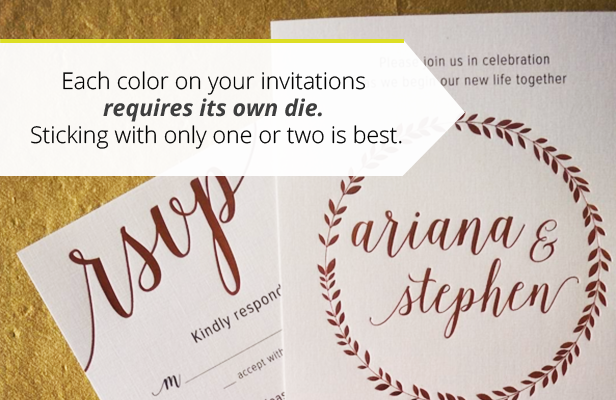
In addition, most people don’t realize that they can just have the wedding invitations themselves printed using letterpress. This keeps the main focus on the invitation itself, plus there’s nothing wrong with flat printing your RSVP cards or sheets of directions, or have them printed using a digital printing process on letterpress weight paper!
Details Worth Splurging On
After drawing up your wedding budget, maybe you discovered you have a little more cash to play with than you previously thought. Maybe you’ve been meticulous and frugal so far, so now you want to spoil yourself with personalized printing touches that are truly special.
One idea is that you could have your letterpress invites foil stamped. Foil stamping involves applying a film of foil to paper, whether it’s metallic, gloss, matte or tinted. Adding this feature can be worth splurging on, especially if you’ve chosen to be frugal elsewhere, or add it selectively for maximum impact.
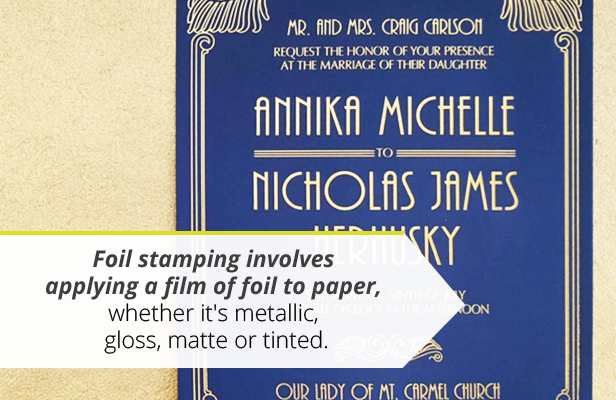
Shiny print isn’t the only detail that’s splurge-worthy. Once the printing has been completed, consider calligraphy services. This will add the finer details you wanted onto your invitations, or it could make the recipient’s address really stand out on the envelope.
Finally, it’s worth paying extra for thick, high-quality paper. Letterpress printing functions better when it isn’t pressing onto a thin page, so the technique can produce the deep impression that it’s supposed to. It’s a difference you can feel.
Best Practices for Ordering Letterpress Invitations
Once you’re ready to place an order with a printer, it can still seem overwhelming. Be reassured that letterpress print shops are ready to help you with every step of the process. The very nature of letterpress printing lends itself to custom orders and new ideas. Here is a brief overview of the ordering process to help you get familiar with what to expect:
Start by getting in touch with a graphic designer to draw up your design. A designer should send you a digital proof of what the finished product will look like before you move forward with the printing. Once approved, the designer will need to vectorize the design before sending it to the printer so every aspect will print correctly. Vectorizing basically means translating a piece of artwork into paths so it can be resized in whatever way necessary without losing its sharpness.
Be as specific as possible about what you want — size and quantity of invites, number of ink colors — so you can get a more accurate price quote. Since letterpress printing is such a unique product based on material used, number of colors and variety of finishes, most shops will provide you with a custom quote as opposed to keeping a standard pricing list.
Customer service is key when it comes to printing letterpress wedding invitations. If you end up wanting last-minute design changes, additional colors or multiple press runs, the printer will discuss these choices with you and explain how much they’ll add to the bill or the turnaround time. More often than not, rush orders on letterpress printing aren’t feasible. Depending on the size of the order, most projects take at least two weeks for the printing to be completed. Revisions or extras like foil stamping can lengthen the process.
That being said, don’t be afraid to ask your printer questions about your order! They want to help you produce your vision while staying within your budget and timeline as much as possible, and they should provide you with full descriptions of the process as well as a clear budget and schedule.
Letterpress wedding invitations have a personal, deliberate feel that many couples love. If you want to keep things simple, you could go with traditional letterpress printing or take advantage of modern innovations like custom digital printing that allow for the addition of more complex designs and color palettes.
Whatever your preference, contact Locust Street Press today if you have a design that you want to turn into your dream wedding invitation using letterpress printing, or a combination of techniques. We can help turn your vision into reality!
Sample Letterpress Invitations:
